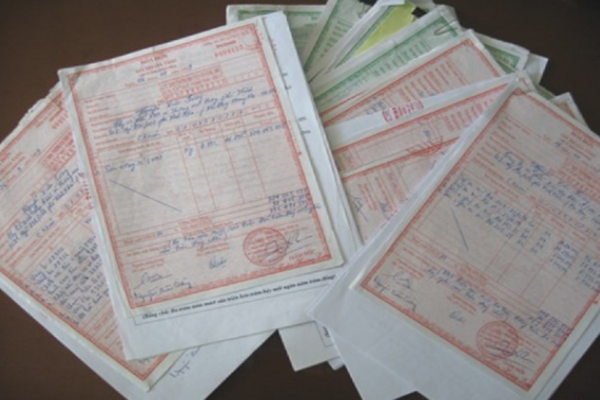Regulations on accounting documents of extra-small enterprises paying CIT in the cit-to-sales ratio (%) in Vietnam
What are the regulations on accounting documents of extra-small enterprises paying CIT in the cit-to-sales ratio (%) in Vietnam? What are the accounting methods of extra-small enterprises? - Van Dai (Ben Tre, Vietnam)

Regulations on accounting documents of extra-small enterprises paying CIT in the cit-to-sales ratio (%) in Vietnam (Internet image)
Regarding this issue, LawNet would like to answer as follows:
1. Regulations on accounting documents of extra-small enterprises paying CIT in the cit-to-sales ratio (%) in Vietnam
According to Article 15 of Circular 132/2018/TT-BTC, extra-small enterprises paying CIT in the cit-to-sales ratio (%) shall use accounting documents listed hereunder:
- Extra-small enterprises paying CIT in the cit-to-sales ratio (%) shall use accounting documents listed hereunder:
|
No. |
Description |
Code |
||
|
I |
Accounting documents prescribed in Circular 132/2018/TT-BTC. |
|
||
|
1 |
Cash receipt |
|
||
|
2 |
Cash payment note |
|
||
|
3 |
Goods-received note |
|
||
|
4 |
Goods dispatch note |
|
||
|
5 |
Wage, salary and other income payment worksheet |
|
||
|
II |
Accounting documents prescribed by other laws on taxes |
|
||
|
1 |
VAT or sales invoices |
|
||
|
2 |
Slip of payment of taxes to the State Budget |
|
||
|
3 |
Bank’s Debit note |
|
- Forms, charts or templates of accounting documents, contents and methods of formulation of accounting documents, referred to in clause 1 of Article 15 of Circular 132/2018/TT-BTC, shall be subject to instructions given in the Appendix 1 “Forms or templates and methods of formulation of accounting documents” attached to Circular 132/2018/TT-BTC.
In addition to accounting documents referred to in clause 1 of this Article, extra-small enterprises may opt to use accounting documents referred to in clause 1 of Article 9 of Circular 132/2018/TT-BTC or the Circular 133/2016/TT-BTC in order to meet requirements concerning management of business activities of these enterprises.
- Sales invoices
+ Sales invoice is an accounting documents recording completed sales of goods or services. Sales invoices may be either VAT invoices or sales receipts depending on legislative regulations on taxes applied to specific methods of payment of VAT employed by extra-small enterprises, including:
++ With respect to extra-small enterprises paying VAT according to the withholding method, sales invoices issued to clients shall be VAT invoices.
++ With respect to extra-small enterprises paying VAT according to the income method, sales invoices issued to clients shall be sales receipts.
+ Sales invoices issued by extra-small enterprises to clients upon sale of goods or services shall serve as a basis for determining their CIT obligations to the State Budget.
- Documents evidencing payment of wages, salaries and other incomes to employees shall serve as a basis for determining PIT obligations of these enterprises’ employees to the State Budget.
- Documents evidencing payment of taxes to the State Budget shall serve as a basis for assessing fulfillment of tax obligations of extra-small enterprises to the State Budget.
2. Accounting method of extra-small enterprises in Vietnam
Accounting method of extra-small enterprises in Vietnam according to Article 16 of Circular 132/2018/TT-BTC is as follows:
- If extra-small enterprises paying CIT calculated according to the method of calculation of CIT based on the CIT-to-sales ratio (%) do not wish to open accounts:
They shall not be bound to do so, but may make entries by using the single-entry bookkeeping method in accounting books (in a way of only recording business transactions into entries or accounts for monitoring purposes and not needing to post corresponding and opposite entries to different accounts) in order to keep track of revenues and incomes, taxes payable to the State, salaries, wages or other amounts retained from salaries or wages, etc. for the purposes of determining their tax obligations to the State Budget.
- If extra-small enterprises paying CIT calculated according to the method of calculation of CIT based on the CIT-to-sales ratio (%) wish to use bookkeeping accounts like those paying CIT calculated according to the method of calculation of CIT based on assessable income in order to meet the demands of management of their business activities:
They shall be entitled to do so by applying regulations set forth in Chapter II of Circular 132/2018/TT-BTC.
- Cases of land rent exemption and reduction under the latest regulations in Vietnam
- Economic infrastructure and social infrastructure system in Thu Duc City, Ho Chi Minh City
- Regulations on ordination with foreign elements in religious organizations in Vietnam
- Increase land compensation prices in Vietnam from January 1, 2026
- Determination of land compensation levels for damage during land requisition process in Vietnam
- Who is permitted to purchase social housing according to latest regulations in Vietnam?
-

- Vietnam: General provisions on accounting documents ...
- 14:15, 10/07/2024
-

- Instruction on filling in the Timesheet and Some ...
- 18:26, 09/07/2024
-

- Instructions for preparing and signing accounting ...
- 16:07, 06/02/2024
-

- What types of accounting documents that have to ...
- 17:08, 03/02/2024
-

- What are the responsibility of accounting units ...
- 12:07, 22/01/2024
-

- Notable new policies of Vietnam effective as of ...
- 16:26, 11/04/2025
-
.Medium.png)
- Notable documents of Vietnam in the previous week ...
- 16:21, 11/04/2025
-
.Medium.png)
- Notable documents of Vietnam in the previous week ...
- 16:11, 02/04/2025
-
.Medium.png)
- Notable new policies of Vietnam to be effective ...
- 16:04, 02/04/2025
-
.Medium.png)
- Notable new policies of Vietnam effective from ...
- 14:51, 21/03/2025

 Article table of contents
Article table of contents

